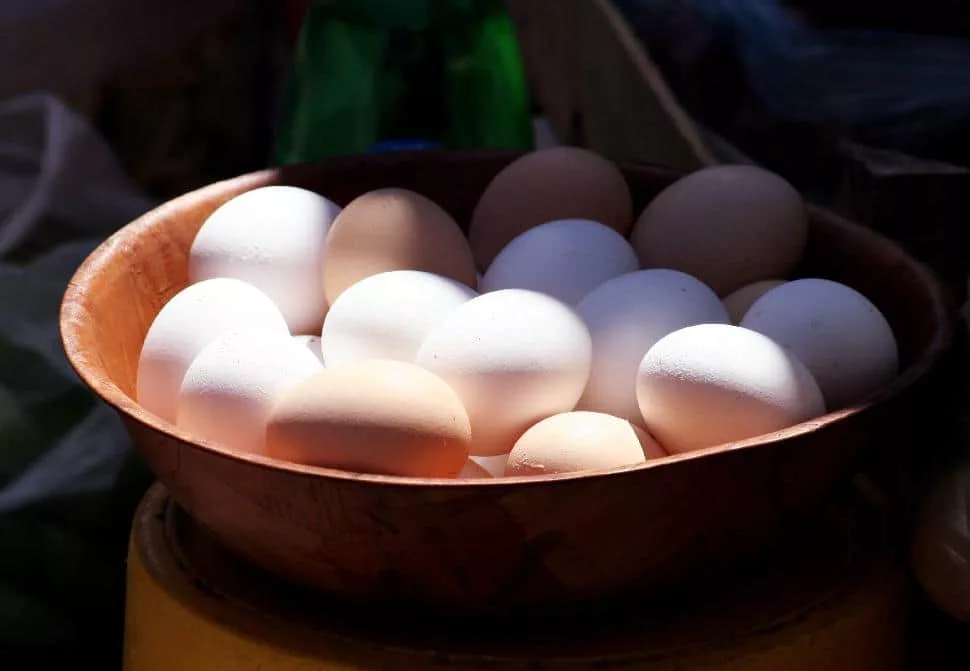The Happy Camper: How to Pack Fresh Eggs

Powdered eggs aren’t as bad as they used to be, but I can’t seem to get past that greenish hue that shines off the top-layer once they’re cooked up. It always seems to launch a gag reflex.
That’s why I choose to pack in fresh farm eggs, or what some wilderness trekkers call “hippy eggs.” These are eggs that come from a known source, squeezed out of healthy chickens liv’n the good life on some country farm. Store-bought eggs are fine for those weekend warriors looking for a bit of tasty protein to go with their fried ham in the morning — but on longer wilderness trips, a “hippy egg” has a greater chance of staying fresh throughout.
Here’s the scoop. Store-bought eggs have a shelf life of four to five weeks in your refrigerator, but only a day or two once removed. A farm fresh egg can last over a month in your pack if it’s kept dry and at a constant and cool-ish temperature. The difference between the two is the fluctuation of temperature and the amount of mucus on the egg.
First off, eggshell is porous — it allows oxygen to pass through when a baby chick is snuggled within. Shifting temperatures — from storage, to the supermarket, to your fridge, then eventually to inside your pack — increase the chance of moisture getting into the egg and spoiling it. Not to mention, the store-bought egg has been out of the chicken for some time before it even gets to the supermarket — let alone your pack. They’re also washed, removing the protective cuticle — mucus that’s politely labelled “bloom,” which seals out bacteria. This is why a momma chicken can sit on her egg for 21 days without it rotting and smelling up the barn. Removing the coating increases the chance of spoilage. That’s right — mucus on your egg is a good thing. It’s also why the Boy Scout manual suggests slathering on a layer of mineral oil or Vaseline to any store-bought eggs.
A near-death encounter from salmonella is rare from consuming eggs. The egg experts say there is a 1 in 10,000 chance of getting food poisoning. Also, the salmonella itself is derived from being laid by sick chickens or poor food handling, so you can actually get salmonella whether the egg is past its prime or not. Cooking it well done and not over-easy should reduce your chances. An egg with salmonella doesn’t have a smell either. But one that’s been infected by bad bacteria does; a foul sulfur stench, worse than a pair of socks worn across the entire West Coast Trail.
Testing the egg’s edibility prior to cracking it open is possible. There’s an age-old trick of floating it in water — similar to the witch-testing method from Monty Python and The Holy Grail. If the egg sinks and lies on its side, it’s very fresh. If it lies on an angle it’s moderately fresh. If it stands on end, it’s best to eat it soon. And if it floats, it is rotten and should only be used by immoral pre-teens to toss at passing cars on Halloween.
Storing the egg without breaking it should cause you more concern than getting sick from it. Some campers have experimented with cracking it open before the trip and storing the liquid gooey contents in a Nalgene. The method seems logical — and Rocky-esque — but the moment it leaves its shell the egg becomes a breeding ground for harmful bacteria. Remember, the shell is the egg’s best friend. The most sensible place to store them is the carton they came in, stuffed in the centre of your pack, well cushioned from impact and safe from meeting the same demise as Humpty Dumpty. Those plastic egg containers are a step up; just make sure to place a layer of paper towel across the top to avoid premature cracking (if the egg is cracked, don’t eat the contents). Coleman has a good container if you’re looking to store a full dozen, and can be picked up at most large chain stores like Canadian Tire. Coghlan’s egg containers are the most common, however. They come in dozen, half-a-dozen and I’ve even seen a two-egg holder at MEC.
If you’re a canoeist, then you’re best to do what a chicken does and sit on it. Store the egg container under your stern seat, fastened by duct-tape. It works perfectly.
An egg can be put over noodles, placed in a casserole, used for quiche, placed on a sandwich, layered on toast, mixed in pancake batter, poached, scrambled, baked, shirred, basted, steamed, hard-boiled, and even used as a pizza topping — but the best way to cook it while camping is to fry it. Layer the bottom of the frying pan with butter, oil, or better yet a bit of bacon grease. If you want it easy-over, use a thin flipper and give it a gentle toss to make sure you don’t break the yolk. Believe it or not, it’s all in the hips; and the older the egg, the more difficult it is to keep the yolk from breaking. There is, however, no need to flip it. To keep it simple — sunny-side up — just crack it in the pan and after a minute add a few drops of water and cover. The steam cooks the yolk and adds to the flavour.
Of course, the alternative is to keep to green eggs and ham. After all, powdered eggs eliminate the phobia of getting sick and greatly reduce the bulk of half-a-dozen eggs wrapped up and stored in your pack like a Royal Doulton figurine. Or better yet, pack a chicken with you and have it pinch out fresh eggs daily. Whatever works for you.
This article originally appeared in our Spring 2013 issue.














